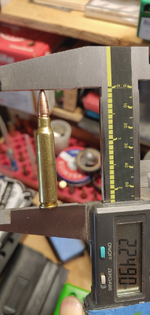- Thread Starter
- #21
@gmerkt lots of good info in your comment. All this is a learning curve for me, being still fairly new to reloading. As a result I'm adjusting my reloading process to include another cleaning step after I size and trim/deburr the cases. I don't really like adding another step to my process but all my loads are for hunting and very small quantity so it isn't adding too much more.
I have to start load dev completely over so Im going to seat the bullet to crimp in the second Hammer PDR band "valley", experimenting I will have to trim my brass to 1.735" to get this. I dont like trimming that short, but these are low volume hunting rounds and seating further out is about .060" more space in the case for powder so maybe another 50fps. Crimping will be a new process for me but experimenting and testing an unchared round shows a very solid seating over 5 cycles thru the AR with zero movement in inertia drift or wiggle or rotation.
Lastly, I will be using my supply of Federal brass and abandoning the Nosler brass.
Picture of my test round after 5 cycles: A nice crimp rolling into the center of the drive band valley rolling nicely over the top of the second drive band. Case trim needed to be 1.735" for this.

and as a side topic, now I know what the black stuff is on a factory 556 load I randomly pulled apart to see. Bullet sealer. An option but I dont think I want to go down this path.

I have to start load dev completely over so Im going to seat the bullet to crimp in the second Hammer PDR band "valley", experimenting I will have to trim my brass to 1.735" to get this. I dont like trimming that short, but these are low volume hunting rounds and seating further out is about .060" more space in the case for powder so maybe another 50fps. Crimping will be a new process for me but experimenting and testing an unchared round shows a very solid seating over 5 cycles thru the AR with zero movement in inertia drift or wiggle or rotation.
Lastly, I will be using my supply of Federal brass and abandoning the Nosler brass.
Picture of my test round after 5 cycles: A nice crimp rolling into the center of the drive band valley rolling nicely over the top of the second drive band. Case trim needed to be 1.735" for this.

and as a side topic, now I know what the black stuff is on a factory 556 load I randomly pulled apart to see. Bullet sealer. An option but I dont think I want to go down this path.












